(Click on images below to start shows; select full screen views)
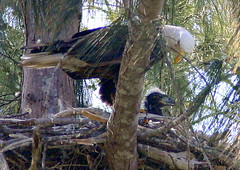
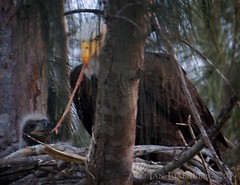
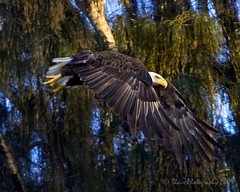

Fernando
Martinez Slideshow ©
2009
|
IMPORTANT MESSAGE: EYES ON EAGLES ARE NEEDED Bald
Eagles usually have a strong attachment to their nests, especially when
they contain eggs or chicks. However, there are certain periods during
their life cycle when disturbances may cause abandonment or
injury. Although we are particularly concerned about human
interference, predators such as crows and raccoons may eat their eggs
and small chicks, and Great Horned Owls may take over an eagle's nest
or kill the chicks.
Eagles may be driven away if disturbed during the nest building and refurbishing period, which occurs from late October through early December for our South Florida eagles. Once the eggs are laid, usually in mid-December, the pair takes turns incubating them and will be quite protective. However, they have been known to abandon a nest even after the eggs are laid if there is continuous unusual harassment. When the eggs hatch, usually in mid-January, Bald Eagle parents are particularly faithful and persistent in caring for their brood, often despite hardships of many kinds. There are usually two chicks, and the greatest danger is faced by the younger chick. Since the eggs are incubated immediately after they are deposited, the youngsters hatch out a few days apart. They grow so rapidly that even a three day interval gives the first hatchling a size and strength advantage over its younger sibling. The big baby aggressively begs to be fed first, and the younger bird may become malnourished if food is not plentiful, and starve to death or be killed and even eaten by its sibling. The older nest-mate often bullies the smaller chick, and may push it out of the nest, which means certain death, even if it survives the fall. Adult eagles, with their huge wing spans, may have trouble flying down to tend to it, and predators, such as foxes, bobcats and raccoons, that often visit the bottom of the tree looking for leftovers would make a quick meal of a fallen bird. However, if and when the eaglets reach about 10 weeks of age, they enter a particularly dangerous time in their life cycle, as they sharpen their flight skills. They flap their wings and jump for hours at a time, climb out on the nest tree limbs and become airborne for a few seconds. While this behavior is essential for them to learn flight skills, it exposes them to the risk of falling to the ground before they are ready to fly freely. If not injured, they usually are able to climb up on the branches of nearby trees and even make their way back to the nest, or succeed in obtaining food from the parents. Once out of the nest, if they survive their first flight, they face new dangers, particularly vehicle collisions and power lines. Roadkill makes an easy meal for the inexperienced youngsters. For the welfare of the eagle chicks, it will be important to have informed eagle watchers present as much of the time as possible. Particularly interesting will be for us to document when these chicks stop returning to the nest to feed and to sleep. We assumed that they would be gone by early May, but they actually kept returning to the nest to be fed, until early June (A report that details some key events in the 2008-2009 breeding season may be accessed here-- PDF Format). While 100% coverage by observers may not be necessary, we hope many of you are able to return regularly to stand watch. To help coordinate efforts and spread out coverage as much as possible, you may choose to use the FORUM on this Web page, and enter the days and times you may be able to stand watch. Of course, report your observations, even if you see no adults or chicks at all during a period of time. Eagle watchers should be vigilant, ready to report any eaglet that appears to be injured. Call Brian Mealey, the wildlife biologist who can assist in the evaluation process and make recommendations / suggestions. His number is 305-975-0200. Or, notify the Florida FWC Wildlife Alert Number: Call 888-404-FWCC (888-404-3922). Cellular phone users, call *FWC or #FWC. No one may enter the posted area around the nest without Florida FWC permission! Trespassers are subject to arrest by local police, as well as stiff fines under state and federal law for disturbing or touching a wild Bald Eagle. If it is necessary for someone with FWC clearance to access the area near the nest to evaluate the condition of the eaglet, please advise Shawn Denton, Director of Public Works at (Office) 954-437-1111 or (Cell) 954- 538-3644. UNDER
NO CIRCUMSTANCES SHOULD ANYONE ATTEMPT
TO TOUCH OR PICK UP AN EAGLET! |
| PEMBROKE PINES
EAGLE PHOTO
SLIDESHOWS (Click on images below to start shows; select full screen views) |
||
 |
 |
 |
| Ken's Eagle Photos © 2009 | Ian Eisenberg's Eagle Photos © 2009 | Robert Goldman's Eagle Photos © 2009 |
 |
||
|
Fernando
Martinez Slideshow ©
2009
|
Mike Fossler Slideshow © 2009 | |
...........................................................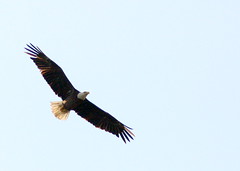 FEB 22: Adult Bald Eagle soaring over nest tree. 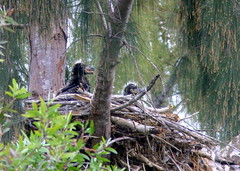 FEB 22: The oldest eaglet, on left, is 5 weeks old today. 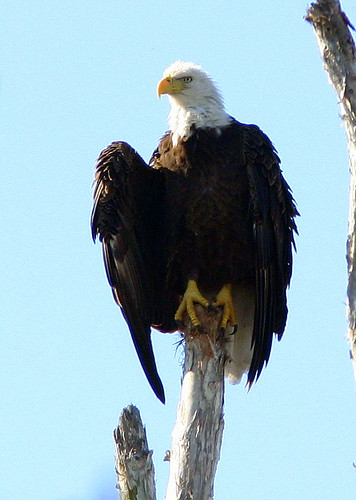 Feb 15: Adult roosting (click on images for larger views) 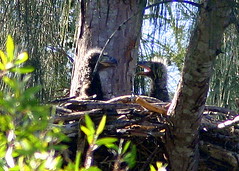 Feb 15: Chicks interacting. The larger, on the left, is 4 weeks old today. 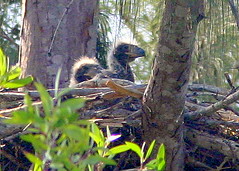 Feb 13: The second chick is now big and strong enough to look over the edge of the nest. 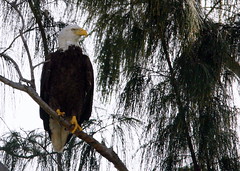 Feb 12: Eagle standing guard 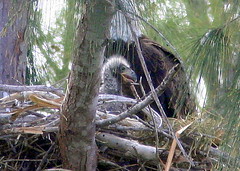 Feb 12: Eaglet in nest with parent 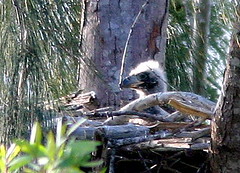 Feb 9: The larger eaglet looks over the edge of the nest (click on photos for larger images) 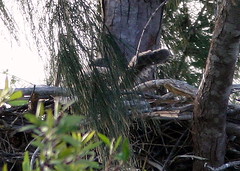 Feb 9: The eaglet flapped its wings several times. 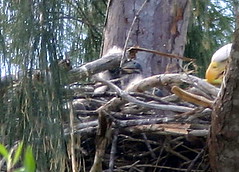 Feb 8: The beaks of two eaglets are visible in this photo. The oldest is three weeks old. Click on it to see a larger annotated image that points out the beaks. Note that the older chick's bill is almost as big as that of the adult. 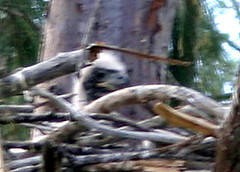 Feb 8: This is a fuzzy shot of the larger chick, now three weeks old. 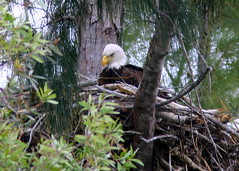 Feb 7: Adult is sheltering chick(s) against wind and rain. 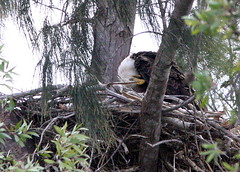 Feb 6: Chick is sitting up as parent preens. Click on photo for larger, annotated views. 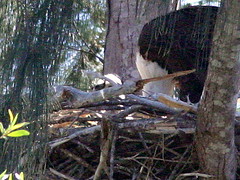 Feb 4: Head of chick is visible as parent tears at prey (click on above photo for larger, annotated view). 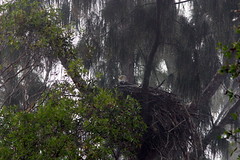 Jan 30: It was quite foggy, and the adult sat close. 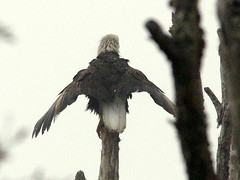 Jan 30: This eagle roosted near the nest, drying its outstretched wings. 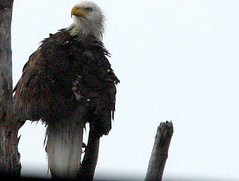 Jan 30: It was one wet eagle! 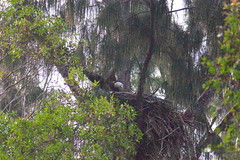 Jan 30: Eagle feeding chick(s) in nest. 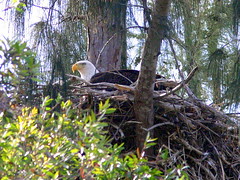 Jan 27: Eagle sitting high on the nest, the first day we saw one of the eaglets. |
Observations
from 2008-2009 Breeding Season
UPDATES ARE NOW POSTED ON KEN'S BLOG FOLLOW THESE LINKS: Subscribe to Ken's Blog (RSS)  What
opens one's eyes to the wonders of nature? The great birder and author
Roger Tory Peterson described his "epiphany," when, as a child, he
picked up an apparently dead flicker and it sprung to life in his hands
and flew off. There was something about seeing the beauty of the bird's
intricate and colorful plumage so close at hand that ignited a passion
that was to change the world, not only for Roger, but for so many who
found, in his field guides, a portal that, once opened, would never
close. We have seen such a transformation occur among many of the
people who visited our neighborhood Bald Eagle nest in Pembroke Pines,
Florida. With a little help from the volunteer nest-watchers, "lookers"
often turned into "observers" right before our eyes. As observers, they
instantly developed an insatiable thirst for knowledge and
understanding, that may lead to greater appreciation and concern, and
spill over into a new ethic of conservation. » Read
full article on[Rosyfinch Ramblings] What
opens one's eyes to the wonders of nature? The great birder and author
Roger Tory Peterson described his "epiphany," when, as a child, he
picked up an apparently dead flicker and it sprung to life in his hands
and flew off. There was something about seeing the beauty of the bird's
intricate and colorful plumage so close at hand that ignited a passion
that was to change the world, not only for Roger, but for so many who
found, in his field guides, a portal that, once opened, would never
close. We have seen such a transformation occur among many of the
people who visited our neighborhood Bald Eagle nest in Pembroke Pines,
Florida. With a little help from the volunteer nest-watchers, "lookers"
often turned into "observers" right before our eyes. As observers, they
instantly developed an insatiable thirst for knowledge and
understanding, that may lead to greater appreciation and concern, and
spill over into a new ethic of conservation. » Read
full article on[Rosyfinch Ramblings]June 9: Nelson Lake Bald Eagle Flashback I
do miss visiting the local Bald Eagle nest in Pembroke Pines, Florida.
Those frequent short trips to the eagles' territory usually yielded
great views of the majestic raptors. Their first chick fledged 66 days
ago, on May 4, and the second left the nest two days later. Although
they soon flew freely and effortlessly and by now have surely developed
their hunting instincts, they continued to return to the nest for
occasional feedings from the parents-- that is, until May 22, after
which Hope, the older eaglet, suddenly disappeared. At about the same
time, the adult female disappeared, leading us to speculate that they
may have migrated together. As of this writing, it appears that
Justice, who was last observed being fed at the nest on May 30, was
last seen on June 4, along with one remaining adult. » Read
full article on[Rosyfinch Ramblings] I
do miss visiting the local Bald Eagle nest in Pembroke Pines, Florida.
Those frequent short trips to the eagles' territory usually yielded
great views of the majestic raptors. Their first chick fledged 66 days
ago, on May 4, and the second left the nest two days later. Although
they soon flew freely and effortlessly and by now have surely developed
their hunting instincts, they continued to return to the nest for
occasional feedings from the parents-- that is, until May 22, after
which Hope, the older eaglet, suddenly disappeared. At about the same
time, the adult female disappeared, leading us to speculate that they
may have migrated together. As of this writing, it appears that
Justice, who was last observed being fed at the nest on May 30, was
last seen on June 4, along with one remaining adult. » Read
full article on[Rosyfinch Ramblings]May 31: Never Eat Anything Bigger Than Your Head Our
time back in Florida has sped by so quickly. Since we had a house
guest,we went sightseeing at several of the popular tourist
destinations. It rained regularly every afternoon, so there were
morning jaunts to Butterfly World, Fort Lauderdale river front and
harbor cruise, and other points along the Atlantic coast and out
Alligator Alley. There was little time for birding, though we took the
tram ride at Shark Valley in Everglades National Park, and got out very
early to visit our local Bald Eagle nest a couple of times. The two
chicks produced by the eagle pair have been flying freely for eight
weeks. We were surprised to find that the parents continued to bring
food to the nest right into this past week. The older chick, named
Hope, was last seen on Saturday, May 23, the eighteenth week after she
hatched. Her younger brother, Justice is still returning to the nest,
and was possibly fed a small meal by a lingering adult only this
morning. The feedings have been progressively smaller and
infrequent. » Read
full article on[Rosyfinch Ramblings] Our
time back in Florida has sped by so quickly. Since we had a house
guest,we went sightseeing at several of the popular tourist
destinations. It rained regularly every afternoon, so there were
morning jaunts to Butterfly World, Fort Lauderdale river front and
harbor cruise, and other points along the Atlantic coast and out
Alligator Alley. There was little time for birding, though we took the
tram ride at Shark Valley in Everglades National Park, and got out very
early to visit our local Bald Eagle nest a couple of times. The two
chicks produced by the eagle pair have been flying freely for eight
weeks. We were surprised to find that the parents continued to bring
food to the nest right into this past week. The older chick, named
Hope, was last seen on Saturday, May 23, the eighteenth week after she
hatched. Her younger brother, Justice is still returning to the nest,
and was possibly fed a small meal by a lingering adult only this
morning. The feedings have been progressively smaller and
infrequent. » Read
full article on[Rosyfinch Ramblings]May 22: Back in Florida! We
arrived back in Florida late on Wednesday, and got out early the next
morning to check our local Bald Eagle nest. The chicks (named Hope and
Justice in a nationwide poll) are 18 weeks old this weekend. They
fledged at 11 weeks of age, and usually spend the night in a roost
together near the nest tree. They still return to the nest for
occasional feedings. The portions brought in by the parents have become
smaller and are offered less frequently. Although none of the nest
observers
has seen either of the eaglets with prey, we must assume that they are
learning to hunt for themselves. When we got to the nest at about 8:30
AM, no eagles were in sight, but within a few minutes both of the
youngsters flew in and roosted in trees right along the road. Justice,
the younger sibling, followed his older sister to the tree... » Read
full article on[Rosyfinch Ramblings] We
arrived back in Florida late on Wednesday, and got out early the next
morning to check our local Bald Eagle nest. The chicks (named Hope and
Justice in a nationwide poll) are 18 weeks old this weekend. They
fledged at 11 weeks of age, and usually spend the night in a roost
together near the nest tree. They still return to the nest for
occasional feedings. The portions brought in by the parents have become
smaller and are offered less frequently. Although none of the nest
observers
has seen either of the eaglets with prey, we must assume that they are
learning to hunt for themselves. When we got to the nest at about 8:30
AM, no eagles were in sight, but within a few minutes both of the
youngsters flew in and roosted in trees right along the road. Justice,
the younger sibling, followed his older sister to the tree... » Read
full article on[Rosyfinch Ramblings]April 28: Finding Spring in Illinois After
participating with a hard-core bunch who have monitored the local Bald
Eagle nest since two eggs were laid in mid-December, we must now be
content in our new role as virtual eagle-watchers. Here is Mike
Fossler's slide show depicting recent events in the lives of the two
Pembroke Pines eaglets, Hope and Justice, now 14 weeks old and flying
freely for three weeks. They still return to the nest to rest and
sometimes are fed by their parents, but they are surely learing how to
find food on their own. It had snowed in Chicagoland the day before we
arrived. To our delight, temperatures had warmed to the high 70s by
noon, and the sun was shining bright. We took our three year old
granddaughter to nearby Jones Meadow Park. While Mary Lou supervised
her at the swings and slides near the park entrance, I walked the 3/4
mile asphalt path that skirts a lake, woods and wetlands to the north,
and the back yards of homes to the south. The brown grasses and sedges
have been flattened by the weight of the past winter's generous
snowfall. Low spots in the meadows and woods are flooded in spots aptly
called "fluddles" by local birders. Various frogs and toads chirp and
croak. The trees are mostly bare, though willows at the edge of the
path are greening up. » Read
full article on[Rosyfinch Ramblings] After
participating with a hard-core bunch who have monitored the local Bald
Eagle nest since two eggs were laid in mid-December, we must now be
content in our new role as virtual eagle-watchers. Here is Mike
Fossler's slide show depicting recent events in the lives of the two
Pembroke Pines eaglets, Hope and Justice, now 14 weeks old and flying
freely for three weeks. They still return to the nest to rest and
sometimes are fed by their parents, but they are surely learing how to
find food on their own. It had snowed in Chicagoland the day before we
arrived. To our delight, temperatures had warmed to the high 70s by
noon, and the sun was shining bright. We took our three year old
granddaughter to nearby Jones Meadow Park. While Mary Lou supervised
her at the swings and slides near the park entrance, I walked the 3/4
mile asphalt path that skirts a lake, woods and wetlands to the north,
and the back yards of homes to the south. The brown grasses and sedges
have been flattened by the weight of the past winter's generous
snowfall. Low spots in the meadows and woods are flooded in spots aptly
called "fluddles" by local birders. Various frogs and toads chirp and
croak. The trees are mostly bare, though willows at the edge of the
path are greening up. » Read
full article on[Rosyfinch Ramblings]April 19: Mob Attacks Eagles! Why
do small birds sometimes seem to put themselves at risk by harrassing
and even attacking much larger raptors? I have seen fragile little
chickadees, titmice, and nuthatches join larger robins and jays to
surround and scold a hapless Long-eared Owl or Red-tailed Hawk.
Sometimes, mammals such as chipmunks and squirrels join the birds,
calling excitedly and flicking their tails nervously. Red-winged
Blackbirds are known perch on the backs of larger hawks to pluck a few
feathers as they drive them away from their nesting grounds. In my New
Mexico back yard, I once watched several Mountain Chickadees and
Bushtits join a group of jays and Clark's Nutcrackers to take on a
Merlin that was perched out in the open. The small falcon could have
easily made a meal of even the larger birds, yet it merely held fast to
its perch and appeared to be screaming back at the annoying assembly.
Many of us have seen mockinbirds attack alley cats, actually striking
them on their backs. (In Dallas, I saw a cat actually catch and kill a
mockingbird doing just this). In Alaska, I was mobbed by Arctic Terns
when I approached too close to their nesting colony. » Read
full article on[Rosyfinch Ramblings] Why
do small birds sometimes seem to put themselves at risk by harrassing
and even attacking much larger raptors? I have seen fragile little
chickadees, titmice, and nuthatches join larger robins and jays to
surround and scold a hapless Long-eared Owl or Red-tailed Hawk.
Sometimes, mammals such as chipmunks and squirrels join the birds,
calling excitedly and flicking their tails nervously. Red-winged
Blackbirds are known perch on the backs of larger hawks to pluck a few
feathers as they drive them away from their nesting grounds. In my New
Mexico back yard, I once watched several Mountain Chickadees and
Bushtits join a group of jays and Clark's Nutcrackers to take on a
Merlin that was perched out in the open. The small falcon could have
easily made a meal of even the larger birds, yet it merely held fast to
its perch and appeared to be screaming back at the annoying assembly.
Many of us have seen mockinbirds attack alley cats, actually striking
them on their backs. (In Dallas, I saw a cat actually catch and kill a
mockingbird doing just this). In Alaska, I was mobbed by Arctic Terns
when I approached too close to their nesting colony. » Read
full article on[Rosyfinch Ramblings]April 17: Exceeding my Bird RDA with a baby Killdeer We
have been spending so much time with our Bald Eagle family that I have
suffered from a deficiency of my RDA, BirdChaser’s
“Recommended Daily
Allowance” of 20 bird species. Yesterday morning, the
temperature was a
crisp 68 degrees as we started our morning walk into the West Miramar
Environmentally Sensiteve Land (ESL), our local birding "patch.". As
before, we kept up a brisk pace on the way out. Near our 1 1/2 mile
turnaround point on the gravel road, I began falling back to take more
pictures. I understood when Mary Lou wanted to keep up the pace, and
watched her disappear in the distance. Photographers can really be a
bore as they retract into their own little world of composition and
exposure. An excited Killdeer flew across my path. Fluttering on the
ground and looking for all the world as if it were mortally wounded, it
was telling me that I had approached too near its nest. I applied
"reverse Kildeer logic" to quickly find the nest. If the Kildeer ran
right, I went to my left. If it ran away, I turned around. As I got
nearer the nest, the distraction display was more fervent, and its
rufous red tail and rump became all the more visible. » Read
full article on[Rosyfinch Ramblings] We
have been spending so much time with our Bald Eagle family that I have
suffered from a deficiency of my RDA, BirdChaser’s
“Recommended Daily
Allowance” of 20 bird species. Yesterday morning, the
temperature was a
crisp 68 degrees as we started our morning walk into the West Miramar
Environmentally Sensiteve Land (ESL), our local birding "patch.". As
before, we kept up a brisk pace on the way out. Near our 1 1/2 mile
turnaround point on the gravel road, I began falling back to take more
pictures. I understood when Mary Lou wanted to keep up the pace, and
watched her disappear in the distance. Photographers can really be a
bore as they retract into their own little world of composition and
exposure. An excited Killdeer flew across my path. Fluttering on the
ground and looking for all the world as if it were mortally wounded, it
was telling me that I had approached too near its nest. I applied
"reverse Kildeer logic" to quickly find the nest. If the Kildeer ran
right, I went to my left. If it ran away, I turned around. As I got
nearer the nest, the distraction display was more fervent, and its
rufous red tail and rump became all the more visible. » Read
full article on[Rosyfinch Ramblings]
 The
adult quickly roosted on the tree to the east of the nest. Hope, the
older and larger eaglet, began eating, and Justice was watching. This
was typical behavior for the younger brother. As a small chick, he
would wait patiently while the parent first fed Hope, even turning his
back during the feeding. At times, the adult would deliberately feed
the smaller chick despite the incessant begging of his older sister. We
said that Hope, if a human, would have been classified as a "Type A"
personality, and Justice as a Type "B." Indeed Justice exhibited some
of the seething resentment and frustration that some human "quiet
types" may suffer. » Read
full article on[Rosyfinch Ramblings] The
adult quickly roosted on the tree to the east of the nest. Hope, the
older and larger eaglet, began eating, and Justice was watching. This
was typical behavior for the younger brother. As a small chick, he
would wait patiently while the parent first fed Hope, even turning his
back during the feeding. At times, the adult would deliberately feed
the smaller chick despite the incessant begging of his older sister. We
said that Hope, if a human, would have been classified as a "Type A"
personality, and Justice as a Type "B." Indeed Justice exhibited some
of the seething resentment and frustration that some human "quiet
types" may suffer. » Read
full article on[Rosyfinch Ramblings]April 12: “Chuck Wagon” for Bald Eaglets There
is great value in observing nature rather than just reading about it.
In the case of Bald Eagles, one can find conflicting information, often
anecdotal, but probably valid in single instances. For example, it has
been said that when the chicks are almost ready to fly, the parents
begin to deprive the chick of food. The presumed survival advantage is
that the fattened chick will lose weight, and thus become more
proficient in free flight. It is also stated that the parent may "lure"
the chick out onto branches in an effort to get it to fly. We have seen
neither of these behaviors at our local Pembroke Pines, Florida nest.
They climbed out on branches of their own accord. Both of the chicks
fledged at approximately 11 weeks of age, just as expected. In the days
preceding their departure from the nest, we saw no decrease in the
number of feedings or the size or amount of prey items. » Read
full article on[Rosyfinch Ramblings] There
is great value in observing nature rather than just reading about it.
In the case of Bald Eagles, one can find conflicting information, often
anecdotal, but probably valid in single instances. For example, it has
been said that when the chicks are almost ready to fly, the parents
begin to deprive the chick of food. The presumed survival advantage is
that the fattened chick will lose weight, and thus become more
proficient in free flight. It is also stated that the parent may "lure"
the chick out onto branches in an effort to get it to fly. We have seen
neither of these behaviors at our local Pembroke Pines, Florida nest.
They climbed out on branches of their own accord. Both of the chicks
fledged at approximately 11 weeks of age, just as expected. In the days
preceding their departure from the nest, we saw no decrease in the
number of feedings or the size or amount of prey items. » Read
full article on[Rosyfinch Ramblings]April 9: Hope and Justice reunited on nest Hope
was joined on the nest yesterday by her younger nest-mate. Hope had
fledged on April 4, and Justice tested his wings two days later. Both
appeared to fall to the ground and there were fears they may had been
injured. In both cases, Florida Fish & Wildlife agents promptly
conducted searches of the nest area, but failed to find them. The
parents kept bringing food to the nest, instinctively luring the chicks
back. Driven by hunger, Hope returned to the nest site after 36 hours
and was on the nest April 6. That same morning, Justice went missing,
but suddenly flew into the nest tree yesterday, April 8, and later in
the day joined his big sister on the nest. » Read
full article on[Rosyfinch Ramblings] Hope
was joined on the nest yesterday by her younger nest-mate. Hope had
fledged on April 4, and Justice tested his wings two days later. Both
appeared to fall to the ground and there were fears they may had been
injured. In both cases, Florida Fish & Wildlife agents promptly
conducted searches of the nest area, but failed to find them. The
parents kept bringing food to the nest, instinctively luring the chicks
back. Driven by hunger, Hope returned to the nest site after 36 hours
and was on the nest April 6. That same morning, Justice went missing,
but suddenly flew into the nest tree yesterday, April 8, and later in
the day joined his big sister on the nest. » Read
full article on[Rosyfinch Ramblings]April 7: Justice falls, and Hope soars Yesterday,
Lou Greenwell, one of the watchers of our local Bald Eagle nest, called
me at around 7:40 AM to report that the younger chick, Justice, had
just flown off the nest and fallen to the ground. Only two days
earlier, Hope, the older eagle fledged and disappeared for 36 hours,
before suddenly returning the the nest tree. Mary Lou and I joined Lou
and Ed Mattis at the nest at about 8:10 AM.We were astonished to learn
that Lou had videotaped the entire episode! A beautifully edited
segment is posted on YouTube, and is embedded here. » Read
full article on[Rosyfinch Ramblings] Yesterday,
Lou Greenwell, one of the watchers of our local Bald Eagle nest, called
me at around 7:40 AM to report that the younger chick, Justice, had
just flown off the nest and fallen to the ground. Only two days
earlier, Hope, the older eagle fledged and disappeared for 36 hours,
before suddenly returning the the nest tree. Mary Lou and I joined Lou
and Ed Mattis at the nest at about 8:10 AM.We were astonished to learn
that Lou had videotaped the entire episode! A beautifully edited
segment is posted on YouTube, and is embedded here. » Read
full article on[Rosyfinch Ramblings]April 5: Searching for Hope, and her return Sunday,
April 5th has been a long and tiring day, but very rewarding. As you
may know, Hope, the older of the two neighborhood Bald Eagle chicks in
Pembroke Pines, Florida, suddenly left the nest at 7:30 AM yesterday,
April 4th. Hope was exactly 11 weeks old, the average age that eagle
chicks fledge. It was a great milestone in Hope's long journey into
life as an adult. Hope's first flight was very brief, consisting of a
couple of circles in front of the nest, then a dash to a nearby tree to
the southwest. She was said to have crashed rather audibly into the
upper branches, as if unable to purchase a grip, then dropped rapidly
straight down, not to be seen again. Mary Lou and I did not see the
event, having gotten to the site at about 8:00 AM, so we reconstructed
it from the descriptions of eye witnesses who had arrived before
sunrise to stand watch at the nest. » Read
full article on[Rosyfinch Ramblings] Sunday,
April 5th has been a long and tiring day, but very rewarding. As you
may know, Hope, the older of the two neighborhood Bald Eagle chicks in
Pembroke Pines, Florida, suddenly left the nest at 7:30 AM yesterday,
April 4th. Hope was exactly 11 weeks old, the average age that eagle
chicks fledge. It was a great milestone in Hope's long journey into
life as an adult. Hope's first flight was very brief, consisting of a
couple of circles in front of the nest, then a dash to a nearby tree to
the southwest. She was said to have crashed rather audibly into the
upper branches, as if unable to purchase a grip, then dropped rapidly
straight down, not to be seen again. Mary Lou and I did not see the
event, having gotten to the site at about 8:00 AM, so we reconstructed
it from the descriptions of eye witnesses who had arrived before
sunrise to stand watch at the nest. » Read
full article on[Rosyfinch Ramblings]March 29: Sibling Rivalry There
was an interesting interaction between the two eaglets this morning.
Hope turned 10 weeks old today. Justice is 5 days younger, but appears
disproportionately smaller. Hope appeared to wear herself out by
flapping and jumping high into the air. Once, she climbed about 3 feet
out on one of the branches that support the right side of the nest.
This seemed to tire her out, as she settled down out of sight. Justice,
as usual, "hunkered down" while the older chick was jumping and
flapping all over the nest. Earlier, we have even seen him passively
tolerate being stepped on by his big sister. Now, as soon as Hope
started snoozing, Justice decided it was his turn to exercise. » Read
full article on[Rosyfinch Ramblings] There
was an interesting interaction between the two eaglets this morning.
Hope turned 10 weeks old today. Justice is 5 days younger, but appears
disproportionately smaller. Hope appeared to wear herself out by
flapping and jumping high into the air. Once, she climbed about 3 feet
out on one of the branches that support the right side of the nest.
This seemed to tire her out, as she settled down out of sight. Justice,
as usual, "hunkered down" while the older chick was jumping and
flapping all over the nest. Earlier, we have even seen him passively
tolerate being stepped on by his big sister. Now, as soon as Hope
started snoozing, Justice decided it was his turn to exercise. » Read
full article on[Rosyfinch Ramblings]March 28: A Two Moccassin Saturday This
morning was overcast, breezy and pleasant. About a month ago a
Black-bellied Whistling-Duck flew noisily right over my head while
walking the Harbor Lakes portion of the West Miramar Environmentally
Sensitive Area that I call my birding "patch." This Mexican species has
spread to areas just north of Broward County (see my photo of one in
western Palm County), but I was not aware of any local sightings. I
believe these ducks usually are seen in flocks, so I wondered if it
might be an escaped or feral specimen that are known to be seen
occasionally in southernmost Florida. I returned to the area
frequently, hoping to find the bird and see if there might be a flock
in the area. I have not been able to find any others, but this past
week did find a dozen Black-necked Stilts (they flew away before I
could photograph them), and today a pair of Blue-winged Teal that also
departed before I could get very close.» Read
full article on[Rosyfinch Ramblings] This
morning was overcast, breezy and pleasant. About a month ago a
Black-bellied Whistling-Duck flew noisily right over my head while
walking the Harbor Lakes portion of the West Miramar Environmentally
Sensitive Area that I call my birding "patch." This Mexican species has
spread to areas just north of Broward County (see my photo of one in
western Palm County), but I was not aware of any local sightings. I
believe these ducks usually are seen in flocks, so I wondered if it
might be an escaped or feral specimen that are known to be seen
occasionally in southernmost Florida. I returned to the area
frequently, hoping to find the bird and see if there might be a flock
in the area. I have not been able to find any others, but this past
week did find a dozen Black-necked Stilts (they flew away before I
could photograph them), and today a pair of Blue-winged Teal that also
departed before I could get very close.» Read
full article on[Rosyfinch Ramblings]March 25: Watching Eagle Size and Behavior We
are pretty sure that we can tell the two Bald Eagle chicks apart. The
first egg was laid on December 13 and it hatched on January 17th. The
second hatched about 5 days later. Early on, there was a great size
difference between the two chicks. For the first three weeks they both
sported coats of whitish down. Gradually the down was replaced by black
feathers, The younger chick was only a day or two behind its nest-mate
in losing the last bit of down, which clung to its head like a white
fur skullcap.
Now that both chicks have names and are aver 9 weeks old, the size
discrepancy remains. Hope, the older one, also is much more active and
aggressive. When a parent brings food, Hope eats first, while Justice
usually sits passively on the far side of the nest. After several
minutes, he will move toward the adult and beg to be fed. A couple of
times his begging appeared to be ignored, while the adult actually fed
on the last of a white bird (ibis or egret) that it brought
in. » Read
full article on[Rosyfinch Ramblings] We
are pretty sure that we can tell the two Bald Eagle chicks apart. The
first egg was laid on December 13 and it hatched on January 17th. The
second hatched about 5 days later. Early on, there was a great size
difference between the two chicks. For the first three weeks they both
sported coats of whitish down. Gradually the down was replaced by black
feathers, The younger chick was only a day or two behind its nest-mate
in losing the last bit of down, which clung to its head like a white
fur skullcap.
Now that both chicks have names and are aver 9 weeks old, the size
discrepancy remains. Hope, the older one, also is much more active and
aggressive. When a parent brings food, Hope eats first, while Justice
usually sits passively on the far side of the nest. After several
minutes, he will move toward the adult and beg to be fed. A couple of
times his begging appeared to be ignored, while the adult actually fed
on the last of a white bird (ibis or egret) that it brought
in. » Read
full article on[Rosyfinch Ramblings]March 20: Eagle Science and Middle School Students As
Bald Eagles adapt to the proximity of humans and their activities, what
are the limits of their tolerance to disturbance? Certainly (we
assume), there must be a limit, an end point at which they will
completely avoid us. Walk up to an eagle in the wild, and when we get
within a certain distance, it will first show signs of discomfort or
anxiety that we might detect. Its eyebrows cannot wrinkle into "worry
lines," because the bony structures of its skull give the eagle a
permanent fierce frown. It may exhibit other signs of intolerance--
first by staring at us intently, then shifting its posture in
preparation for flight, and perhaps by vocalizing, or even defecating
to make itself lighter. Then it will fly from its perch, removing
itself from the perceived threat. We could measure these behaviors in
large numbers of rural and urban eagles, and perhaps note a difference
between their reactions at various distances from the
intruder. » Read
full article on[Rosyfinch Ramblings] As
Bald Eagles adapt to the proximity of humans and their activities, what
are the limits of their tolerance to disturbance? Certainly (we
assume), there must be a limit, an end point at which they will
completely avoid us. Walk up to an eagle in the wild, and when we get
within a certain distance, it will first show signs of discomfort or
anxiety that we might detect. Its eyebrows cannot wrinkle into "worry
lines," because the bony structures of its skull give the eagle a
permanent fierce frown. It may exhibit other signs of intolerance--
first by staring at us intently, then shifting its posture in
preparation for flight, and perhaps by vocalizing, or even defecating
to make itself lighter. Then it will fly from its perch, removing
itself from the perceived threat. We could measure these behaviors in
large numbers of rural and urban eagles, and perhaps note a difference
between their reactions at various distances from the
intruder. » Read
full article on[Rosyfinch Ramblings]March 18: Beauty Despite the Doldrums Fish
were concentrated in the ditch that runs along the path, but I was
surprised to find no long-legged wading birds feasting on them. Nor did
I see the usual alligators and Cottonmouth Water Moccasins, as much as
I tried. Though I have found Bobcats and Raccoons there in the past,
none were to be found. Except for a few Common Yellowthroats, no
warblers were around. Even the omnipresent winter Palm Warblers seemed
to have flown north.In fact, this entire area of recovering Everglades
seemed relatively devoid of birds. We are now stuck between the
seasons, missing some of our winter visitors, and awaiting the flush of
northbound migrants. My obvious alternative was to find beauty in the
commonplace. » Read
full article on[Rosyfinch Ramblings] Fish
were concentrated in the ditch that runs along the path, but I was
surprised to find no long-legged wading birds feasting on them. Nor did
I see the usual alligators and Cottonmouth Water Moccasins, as much as
I tried. Though I have found Bobcats and Raccoons there in the past,
none were to be found. Except for a few Common Yellowthroats, no
warblers were around. Even the omnipresent winter Palm Warblers seemed
to have flown north.In fact, this entire area of recovering Everglades
seemed relatively devoid of birds. We are now stuck between the
seasons, missing some of our winter visitors, and awaiting the flush of
northbound migrants. My obvious alternative was to find beauty in the
commonplace. » Read
full article on[Rosyfinch Ramblings]March 17: Needed: More Eyes on the Eagles The
eaglets are approaching a particularly dangerous time in their life
cycle, as they exercise their wings and even attempt to briefly lift up
into the air. Until they capable of free flight, they are at risk of
losing their balance and falling to the ground. Their parents cannot
fly through the trees to feed them, and even if they survive the fall,
they face almost certain death from the foxes, bobcats and raccoons
that congregate under the nest tree every night to find food scraps.
For the welfare of the eagle chicks, it will be important to
haveinformed eagle watchers present as much of the time as
possible. » Read
full article on[Rosyfinch Ramblings] The
eaglets are approaching a particularly dangerous time in their life
cycle, as they exercise their wings and even attempt to briefly lift up
into the air. Until they capable of free flight, they are at risk of
losing their balance and falling to the ground. Their parents cannot
fly through the trees to feed them, and even if they survive the fall,
they face almost certain death from the foxes, bobcats and raccoons
that congregate under the nest tree every night to find food scraps.
For the welfare of the eagle chicks, it will be important to
haveinformed eagle watchers present as much of the time as
possible. » Read
full article on[Rosyfinch Ramblings]March 15: Meet Hope and Justice! Most
of you know that we have asked the public to participate in selecting
the names for the two Pembroke Pines eaglets, from a list prepared by
students at Silver Trail Middle School. The results are in!
The polls just closed, and the two most popular names were HOPE and
JUSTICE. Commonly, there is one male and one female chick. Since
females are usually larger, we will arbitrarily call the older and
noticeably larger one "Hope," and her smaller sibling, "Justice." At
about 8 weeks of age, both chicks are nearly as large as their
parents. » Read
full article on[Rosyfinch Ramblings] Most
of you know that we have asked the public to participate in selecting
the names for the two Pembroke Pines eaglets, from a list prepared by
students at Silver Trail Middle School. The results are in!
The polls just closed, and the two most popular names were HOPE and
JUSTICE. Commonly, there is one male and one female chick. Since
females are usually larger, we will arbitrarily call the older and
noticeably larger one "Hope," and her smaller sibling, "Justice." At
about 8 weeks of age, both chicks are nearly as large as their
parents. » Read
full article on[Rosyfinch Ramblings] March 12: No Parking in Front of Eagle Nest The
Florida Department of Transportation put these signs up yesterday,
prohibiting parking on the entire south side of the block in front of
the eagle nest. At this point, observers are still permitted, and signs
ask folks not to approach any closer to the nest. Visitors can either
park on the souths side of Pines Boulevard, east of 208th Avenue or
west of 209th. Alternatively, there is parking on the shoulder of the
north side of Pines Boulevard, across the street from the nest. Please
do not park on the pavement or in the turning lanes. Use caution in
crossing the street and control children.
The signs face out towards the street, so many people do not even
notice them. We suggest that additional signs should face the oncoming
traffic. » Read
full article on[Rosyfinch Ramblings] The
Florida Department of Transportation put these signs up yesterday,
prohibiting parking on the entire south side of the block in front of
the eagle nest. At this point, observers are still permitted, and signs
ask folks not to approach any closer to the nest. Visitors can either
park on the souths side of Pines Boulevard, east of 208th Avenue or
west of 209th. Alternatively, there is parking on the shoulder of the
north side of Pines Boulevard, across the street from the nest. Please
do not park on the pavement or in the turning lanes. Use caution in
crossing the street and control children.
The signs face out towards the street, so many people do not even
notice them. We suggest that additional signs should face the oncoming
traffic. » Read
full article on[Rosyfinch Ramblings]March 10: Eagle Nest Site Receives More Protection This
morning, a work crew extended a temporary orange plastic barrier fence
to the east and west from the chain link fence along the north boundary
of the 20 acre woodland that holds the Bald Eagle nest. They continued
around both corners, southward. The eastern side now is completely
closed off. The westward section closes off an area that had been used
by trespassers to access the nest site. This fence then continues to
the south into the area of dead melaleuca trees where the eagles like
to roost, discouraging foot traffic by trespassers who want to get
closer for a photo. Two prominent signs, in Spanish and English, were
placed at the viewing area. They do not prohibit parking, but advise
observers not to enter the area in front of the nest that is marked off
by traffic cones. » Read
full article on[Rosyfinch Ramblings] This
morning, a work crew extended a temporary orange plastic barrier fence
to the east and west from the chain link fence along the north boundary
of the 20 acre woodland that holds the Bald Eagle nest. They continued
around both corners, southward. The eastern side now is completely
closed off. The westward section closes off an area that had been used
by trespassers to access the nest site. This fence then continues to
the south into the area of dead melaleuca trees where the eagles like
to roost, discouraging foot traffic by trespassers who want to get
closer for a photo. Two prominent signs, in Spanish and English, were
placed at the viewing area. They do not prohibit parking, but advise
observers not to enter the area in front of the nest that is marked off
by traffic cones. » Read
full article on[Rosyfinch Ramblings]March 8: Chow Time For Eagle Chicks We
arrived at the nest at about 8:45 EDT, and found three other
photographers and observers already there. The said the chicks had been
fed at about 8:00 AM. We waited until 10:30, when one adult flew in
from the rear of the nest unnoticed by the 12 or so people that were
watching at the time. The adult proceeded to feed the fish to the young
birds. The older eaglet, who was seven weeks old this weekend, ate
first. At first, the smaller one looked on, but after its sibling had
eaten several large chunks, the adult began feeding it. » Read
full article on[Rosyfinch Ramblings] We
arrived at the nest at about 8:45 EDT, and found three other
photographers and observers already there. The said the chicks had been
fed at about 8:00 AM. We waited until 10:30, when one adult flew in
from the rear of the nest unnoticed by the 12 or so people that were
watching at the time. The adult proceeded to feed the fish to the young
birds. The older eaglet, who was seven weeks old this weekend, ate
first. At first, the smaller one looked on, but after its sibling had
eaten several large chunks, the adult began feeding it. » Read
full article on[Rosyfinch Ramblings]March 7: Eagles, Warblers and Butterflies Last
evening, Lynda White, EagleWatch Coordinator for Audubon of Florida,
accompanied by "Paige," a 14 year old non-releasable Bald Eagle,
completed a round of appearances in Broward County with a presentation
at Silver Trail Middle School in Pembroke Pines. In her
beautifully-illustrated talk before a large audience, Lynda reviewed
the natural history of the Bald Eagle, and provided many interesting
anecdotes about its life cycle. Following her presentation, members of
the audience gathered around to photograph Paige and exchange eagle
stories. » Read
full article on[Rosyfinch Ramblings] Last
evening, Lynda White, EagleWatch Coordinator for Audubon of Florida,
accompanied by "Paige," a 14 year old non-releasable Bald Eagle,
completed a round of appearances in Broward County with a presentation
at Silver Trail Middle School in Pembroke Pines. In her
beautifully-illustrated talk before a large audience, Lynda reviewed
the natural history of the Bald Eagle, and provided many interesting
anecdotes about its life cycle. Following her presentation, members of
the audience gathered around to photograph Paige and exchange eagle
stories. » Read
full article on[Rosyfinch Ramblings]March 4: This Friday: Florida Audubon Presentation on Florida’s Eagles Plan
to attend the free presentation by Lynda White, EagleWatch Coordinator
for Audubon of Florida, at 6:30 - 8:30 PM this Friday, March 6, at
Silver Trail Middle School in Pembroke Pines. Lynda will be accompanied
by a "Paige" an adult Bald Eagle. She will speak about eagles in
Florida and the Pembroke Pines Bald Eagle nest. The program will be
held in the cafetorium of the Middle School, which is located at the SE
corner of NW 184th Avenue and Sheridan (18300 Sheridan
Street).Refreshments will be served. Be sure to bring your children and
a camera-- Paige likes to have her picture taken! » Read
full article on[Rosyfinch Ramblings] Plan
to attend the free presentation by Lynda White, EagleWatch Coordinator
for Audubon of Florida, at 6:30 - 8:30 PM this Friday, March 6, at
Silver Trail Middle School in Pembroke Pines. Lynda will be accompanied
by a "Paige" an adult Bald Eagle. She will speak about eagles in
Florida and the Pembroke Pines Bald Eagle nest. The program will be
held in the cafetorium of the Middle School, which is located at the SE
corner of NW 184th Avenue and Sheridan (18300 Sheridan
Street).Refreshments will be served. Be sure to bring your children and
a camera-- Paige likes to have her picture taken! » Read
full article on[Rosyfinch Ramblings]March 2: Both Eagle Chicks Faring Well This
afternoon, one of the adults carried in a White Ibis and simply threw
it into the nest with the two chicks. It watched for a while, then set
out tearing at the flesh and feeding the young. Note white feathers
from the ibis stuck on the adult's face. The younger and smaller eaglet
is on the right. It appeared quite vigorous. While the adult was still
feeding the eaglets, the second adult flew in with a large fish. It
appeared a bit hostile at first, as if wanting the job to itself. Then
both adults resumed feeding the chicks. » Read
full article on[Rosyfinch Ramblings] This
afternoon, one of the adults carried in a White Ibis and simply threw
it into the nest with the two chicks. It watched for a while, then set
out tearing at the flesh and feeding the young. Note white feathers
from the ibis stuck on the adult's face. The younger and smaller eaglet
is on the right. It appeared quite vigorous. While the adult was still
feeding the eaglets, the second adult flew in with a large fish. It
appeared a bit hostile at first, as if wanting the job to itself. Then
both adults resumed feeding the chicks. » Read
full article on[Rosyfinch Ramblings]March1: Observations By Volunteer Nest Watchers One
parent was roosting on the melaleucas to the west when I got there.
There were about 15 people at that end, and another 20 or so at the
nest site. All were enthusiastic and well-behaved. No one walked inside
the pylons, and no one brought pets. The adult then flew away to the
south, and only about 5 or 10 minutes later (about 1:30 PM) an adult
came in with prey. It looked like a long thin creature-- I thought too
fat for a snake, and too skinny and long to be a tilapia. Some said it
was a snake and others thought maybe an iguana. It was probably too
long to be one of the sirens that the herons like to catch. The adult
seemed to just drop it into the nest, and the chicks were not visible
as (if) they fed. then a little later it reached down into the nest..
The smaller chick was still on the left side, behind the adult. The
adult flew off after about 20 minutes. Both chicks then popped up and
the larger one did a lot of wing flapping. » Read
full article on[Rosyfinch Ramblings] One
parent was roosting on the melaleucas to the west when I got there.
There were about 15 people at that end, and another 20 or so at the
nest site. All were enthusiastic and well-behaved. No one walked inside
the pylons, and no one brought pets. The adult then flew away to the
south, and only about 5 or 10 minutes later (about 1:30 PM) an adult
came in with prey. It looked like a long thin creature-- I thought too
fat for a snake, and too skinny and long to be a tilapia. Some said it
was a snake and others thought maybe an iguana. It was probably too
long to be one of the sirens that the herons like to catch. The adult
seemed to just drop it into the nest, and the chicks were not visible
as (if) they fed. then a little later it reached down into the nest..
The smaller chick was still on the left side, behind the adult. The
adult flew off after about 20 minutes. Both chicks then popped up and
the larger one did a lot of wing flapping. » Read
full article on[Rosyfinch Ramblings]Feb 28: Twenty-Something Questions About Bald Eagles, While
standing watch at our local Bald Eagle nest in South Florida, visitors
offer many questions. Thrilled to see the two adults and their two
chicks at such close range, their curiosity is aroused and they ply me
and other eagle watchers with questions. Since there is a steady
turnover of visitors, the same questions get asked over and over
again. My
attempt to limit them to a "top 20" list did not succeed, even when I
combined several of the questions. Readers may contact me with more
questions, which I will try to answer. » Read
full article on[Rosyfinch Ramblings] While
standing watch at our local Bald Eagle nest in South Florida, visitors
offer many questions. Thrilled to see the two adults and their two
chicks at such close range, their curiosity is aroused and they ply me
and other eagle watchers with questions. Since there is a steady
turnover of visitors, the same questions get asked over and over
again. My
attempt to limit them to a "top 20" list did not succeed, even when I
combined several of the questions. Readers may contact me with more
questions, which I will try to answer. » Read
full article on[Rosyfinch Ramblings]Feb 26: Eagle Nest Territory Now Officially “Off Limits” Yesterday,
many eagle watchers were alarmed because they only saw one eagle in the
area all day, from 8:30 AM (when they were fed and it was possible that
a second adult brought in the food), until late afternoon. A reporter
from NBC Channel 6 appeared on scene in the early afternoon, and
several people expressed their concerns about the "missing" adult,
fearing it had been injured or killed. I told the reporter that it was
too early to jump to such a conclusion, as the eaglets are fed much
less frequently, now that they can gobble down very large chunks of
prey.
On the early evening news, the reporter voiced these concerns anyway.
Then the second adult showed up and brought in prey at about 5:30 PM. I
notified him and, to his credit, he clarified this in the late news
show. » Read
full article on[Rosyfinch Ramblings] Yesterday,
many eagle watchers were alarmed because they only saw one eagle in the
area all day, from 8:30 AM (when they were fed and it was possible that
a second adult brought in the food), until late afternoon. A reporter
from NBC Channel 6 appeared on scene in the early afternoon, and
several people expressed their concerns about the "missing" adult,
fearing it had been injured or killed. I told the reporter that it was
too early to jump to such a conclusion, as the eaglets are fed much
less frequently, now that they can gobble down very large chunks of
prey.
On the early evening news, the reporter voiced these concerns anyway.
Then the second adult showed up and brought in prey at about 5:30 PM. I
notified him and, to his credit, he clarified this in the late news
show. » Read
full article on[Rosyfinch Ramblings] Feb 23: Pembroke Pines Eagles Attract Attention Quite
a few people are stopping by to look at the Bald Eagle nest and its
occupants. Visitors are asked to park in the grass, several feet away
from the pavement of busy Pines Boulevard. The eagles seem to be more
tolerant of vehicles than humans, so observers should avoid walking
towards the nest. Since the eagles can be disturbed by excessive
motion, eagle watchers should observe quietly and not permit children
to run about. The oldest of the two chicks (on the left in the above
photo) was hatched on January 17th, making it 34 days old
today. » Read
full article on[Rosyfinch Ramblings] Quite
a few people are stopping by to look at the Bald Eagle nest and its
occupants. Visitors are asked to park in the grass, several feet away
from the pavement of busy Pines Boulevard. The eagles seem to be more
tolerant of vehicles than humans, so observers should avoid walking
towards the nest. Since the eagles can be disturbed by excessive
motion, eagle watchers should observe quietly and not permit children
to run about. The oldest of the two chicks (on the left in the above
photo) was hatched on January 17th, making it 34 days old
today. » Read
full article on[Rosyfinch Ramblings]Sunday, February 22, 2009: Media Blitz As a result of the controversy over the construction at the nest, which is now resolved to the benefit of the eagles, the media became involved. After all, over a hundred students have been engaged in the middle school science class study of the effects of traffic density on the birds' behavior. When the utility markers went up there was great anxiety, as no one knew what kind of construction was to occur riht in fron of the nest. Was it a huge utility project like a new sewer line? A sidewalk? As outlined here, despite the full cooperation of local, county and state officials, it took over a week to find out. In the meantime, some local people wanted to picket the site in protest. Cooler heads prevailed. We found out that the planned construction involved the Broward County School Board's installation of a badly-needed traffic signal. The Florida FWC intervened, and the school board ordered that any construction within 330 feet of the nest be postponed until after the eaglets fledge, which should be some time in late March or early April. It is no surprise that someone got the media involved during the controversy. It must have been a dull news week, as suddenly two television stations and the Miami Herald descended on the nest site. First, Channel 4 ran a short clip, but despite our request that they not publicize the location of the nest, they included a map of the site. Then the Miami Herald followed up yesterday morning with an interesting FRONT PAGE STORY which disclosed the "approximate" location. As expected, people flocked to the site, overwhelming the parking space along the road. Cars double parked and blocked traffic lanes. Police had to ask people to move along. Up to 50 cars and over 100 spectators were present at one time on Saturday afternoon. Today was much the same. Despite our fears that their presence might disturb the eagles, we found the visitors to be enthusiastic and usually cooperative. They expressed a high degree of interest and awe. The children enjoyed eye-popping views of the chicks through my spotting scope. The eagles went about their usual routine. The male usually roosted out on one of the melaluca stubs, and the female was often perched nearer the nest. At 5:30 PM, the chicks had their bedtime snack, which appeared to be a snake. This text message from a mother who visited was particularly touching: ...I
am truly blessed to have shared this experience with my children and
tell them how the american eagle was once on the verge of
extinction. but to have a nest so close to my home is even a
bigger blessing. I am in awe never in a lifetime did i think
i
would see what my eyes have seen. It is truly amazing I drive by the
nest everyday 2-3x a day looking in curiousity on my way to
work.
i hope this land is now protected. so the eagles can thrive
again
in broward county. if there is anything i can do to help
protect
the eagles family new home i would love to join in the conservation
efforts. one of the most beautiful images i will ever see is now
forever in my memory and now my children! they will remember
these moments for the rest of their lives! thank you for this
site and your ongoing efforts sincerely...
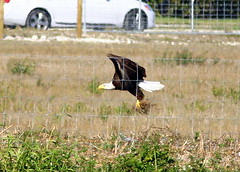 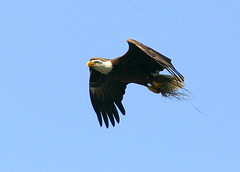 Today,
we observed a common, but interesting habit of Bald Eagles.
They
continue to add materials to the nest after the eaglets are hatched,
bringing in sticks and grasses. The chicks, in turn, have been seen
throwing sticks out of the nest! I have seen similar behavior in Great
Horned Owls, whose chicks may continue to take apart their nest as they
grow up, sometimes leaving nothing there at all when they finally
fledge. Unlike eagles, owl parents do not take steps
to
correct the damage done by such "misbehavior." The photos
above
show an adult just lifting off from the pasture northwest of the nest
tree, picking up grass in its talons, and then flying directly to the
nest, where it spent quite a bit of time working it into the nest
lining. Today,
we observed a common, but interesting habit of Bald Eagles.
They
continue to add materials to the nest after the eaglets are hatched,
bringing in sticks and grasses. The chicks, in turn, have been seen
throwing sticks out of the nest! I have seen similar behavior in Great
Horned Owls, whose chicks may continue to take apart their nest as they
grow up, sometimes leaving nothing there at all when they finally
fledge. Unlike eagles, owl parents do not take steps
to
correct the damage done by such "misbehavior." The photos
above
show an adult just lifting off from the pasture northwest of the nest
tree, picking up grass in its talons, and then flying directly to the
nest, where it spent quite a bit of time working it into the nest
lining.Media representatives were present at the nest viewing area this morning, and saw the two chicks being fed. Look for an upcoming feature in the Miami Herald. This led me to reflect upon the effects and possible benefits of the increasing public knowledge of our local Bald Eagle nest. See: Should Eagle Nest Locations Be Disclosed? Monday, February 16, 2009: Good News Many
of you eagle watchers have met Jesus Hoyos, one of the 7th Grade
Science students from Silver Trail Middle School. We just learned that
this week he won first place in his category (beating out over 50 other
entries) in the Broward County Science Fair and will move up to the
state competition in April. His project was none other than the Bald
Eagles of Pembroke Pines. With input from several work groups in the
120 student class, Jesus assembled the tally sheet that is used in the
study of the effects of traffic density on the behavior of the eagles
at the nest. Congratulations, Jesus, and we wish you the best of luck
in the Florida State finals! The Broward County Audubon Society also
awarded a prize. He will be honored on March 24 at the Broward County
Science Fair Awards Ceremony,at New River Middle School in Fort
Lauderdale.
Sunday,
February 15: Chicks are 4 weeks oldThe day turned windy, and I arrived at the nest around 11 AM, just after the chicks had been fed. Only got a glimpse of the larger chick, but others saw both in the nest earlier in the morning. Note Ian Eisenberg's excellent slide show of the eagles, at the top of the left panel. Click for some fantastic shots of the chicks being fed. Construction should wrap up today, to resume after the chicks fledge, probably in early April. The
oldest chick is 4 weeks old today, having hatched either the afternoon
of January 17 or the morning of the 18th. The first egg was laid
December 13th, 2008. Both of these dates were based upon changes of the
behavior of the pair at the nest. For the same reasons, we also
believed that the second egg was laid on December 18, and we noted that
the adults appeared to stop continuous incubation on January 22, five
days after the first egg hatched.
This morning there was quite a large crowd of observers and photographers. The chicks interacted in a mildly hostile or competitive manner, but there was no wing flapping or wrestling. They may have been hungry, as the fog had just lifted and no prey was brought in during the hour we watched the nest. Fog had just lifted, and morning condensation from the foliage usually drenches the birds. The adult male (distinguished from its mate by its smaller size and darker plumage) spent most of the time drying its feathers at its roost in the dead melaleuca stand to the west of the nest. The above slide show contains all of my Flickr nest photos, arranged with the latest ones first. Please remember to park cars well off the roadway and keep activity to a minimum, as the birds seem to pay more attention to human activity than to vehicular traffic. The contractor is limiting construction to the area over 330 feet from the nest, but feels at risk of some liability if the chicks desert the nest. Please respond politely to any requests to limit activities or crowd size. Ian Eisenberg was taking photos at the nest this morning, and has some wonderful photos of the eagles; his views of the chicks being fed are fabulous! He has permitted us to to view this slideshow (Click here). Saturday, February 14, 2009 You may enjoy viewing this link to a site with a
camera set on a bald eagle's nest at Carolina Raptor
Center, Huntersville, North Carolina. (From Ron Clark, forwarded by
Barbara Walker):
The eagle is Savannah, a non-releasable bird. She is on the display trail at CRC, but the nest is blocked from view to the public. She is sitting on two eggs, which we hope are viable. If so, the chicks will hatch in about 2 1/2 weeks. This is the 4th year since the first captive bald eagles in the state were born. Those two were radio-collared and released. One was tracked as far as the St. Lawrence Seaway. The second year, unfortunately, the eaglets did not survive a massive rainstorm one night. The nest was on the ground. Notice the raised platform in the picture, so hopefully that won't happen again. Last year, one died, but the other was released. Soon, we'll know how this nest turns out. Friday, February 13, 2009 Both
eaglets were standing up high in the nest. The smaller one is about 5
days behind the other in its development, which agrees with our
conclusion, based upon the behavior of the pair, that the first egg was
laid about December 13 and the second around the 18th.
Hatching
dates were most likely January 17 and 22. See today's Blog
about an interesting habit of Bald Eagles: they bring fresh green
leaves to the nest after the young hatch. Why do they do this?
Thursday, February 12, 2009: Eagle Nest on Local TV Timothy
McCoy, who works with Traffic Control Devices, the contractor
installing the traffic light at 209th and Pines, is now monitoring the
eagle nest construction procedures to assure that the 330 foot limit is
observed and the eagles are not being subjected to unusual disturbance.
He is having the workers take such steps as reducing the idle speed of
machinery, and substituting hand labor for mechanized equipment when
feasible. This is a grave responsibility, as the company would be at
risk if their activities are determined to cause harm to the eagles. If
the company believed that the eagles were being unduly disturbed during
their work, they would have the option of cordoning off the entire
easement at the construction site, which would include the eagle
observation area. Interestingly, the eagles were
still roosting peacefully in the melaleuca snags to the west
of
the nest while excavation was in progress, only about 150 to
200
feet away.
This
morning, Tim also noted that one of my photos of the eagle pair
touching bills formed a perfect heart. Therefore, I filled in the space
between them and designed this Valentines greeting for everyone. Eagle
lovers, feel free to copy it. Thanks for the idea, Tim! Tim
will advise eagle watchers if, in his judgement, any activities are
causing an undue disturbance. For example, if a group is too large
and/or noisy, or if children are running around closer to the nest than
the normal viewing location, he may point out his concerns. Keep
vehicles off the roadway. If, in the interest of public
safety, local or State police ask people or vehicles to move
away
from the scene, please comply. Cooperate voluntarily, so that
we
may keep the site open and available to all. Tim
will advise eagle watchers if, in his judgement, any activities are
causing an undue disturbance. For example, if a group is too large
and/or noisy, or if children are running around closer to the nest than
the normal viewing location, he may point out his concerns. Keep
vehicles off the roadway. If, in the interest of public
safety, local or State police ask people or vehicles to move
away
from the scene, please comply. Cooperate voluntarily, so that
we
may keep the site open and available to all. Tim McCoy was interviewed about the eagles in this clip from last evening's news. Tuesday, February 10, 2009: CONSTRUCTION HALTED Good
news for all friends of the Bald Eagles of Pembroke Pines! The The
Environmental Department representative from the Broward
County
School Board "fully supports" the recommendation of the FWC to suspend
all construction within 330 feet of the eagle nest, until the
chicks fledge, probably in April. We commend the School Board for
acting responsibly! This is not the end of the story, as we must
realize that under the Bald Eagle Management Guidelines, ALL unusual
disturbance is also prohibited inside the 330 foot boundary.
This
includes the activities of eagle watchers, who must use utmost caution
to avoid frightening the birds. Within the next month, the eaglets will
reach a critical time when they are more apt to be injured or killed,
as they begin to climb out of the nest and test their wings. If
frightened, they may fall from the tree. Lacking full powers of flight,
they may fall to the ground and, even if they survive the fall, and
risk being killed by a predator, or abandoned by their parents. The
normal vantage point
for viewing or photographing the nest is only 205 feet from
the
nest. While it is true that pedestrians commonly pass back and forth on
the grassy swale at even less distance, and the birds have accomodated
the presence of humans at this distance, the FWC has reminded all of
their responsibilty to observe the 330 foot limitation. More at this link
on the 'History" page.
Monday, February 9, 2009 The
older chick was very active this morning, stretching its neck to look
out at the traffic. Our four year old granddaughter was thrilled to see
the little fuzzy head pop up as she looked at the nest through a
spotting scope. This time I got better images of the eaglet.
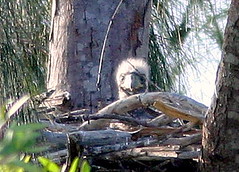 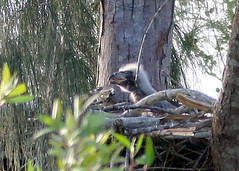 Sunday, February 8, 2009: Two Chicks! There
were many eagle watchers out this weekend. Two healthy-looking chicks
were readily visible this morning, and some excellent photos and videos
were obtained (though not by me, as my camera malfunctioned,
and I
got only two fuzzy images, seen in the left panel-- note how large a
beak the oldest chick has ). The Middle School students are
now
conducting their 7th grade science class project, observing the birds
at regular intervals.. About 120 of them are expressing some agitation
about what and when the construction in front of the nest will occur.
I do feel confident that the people from FWS have provided the contractor with plenty of information and cautions, and they promised to keep us all informed about the status of the School Board eagle permit for the work that occurs more than 330 feet from the nest, if they decided to apply, and whether they will delay construction for a few weeks until the chicks fledge. FWS guidelines prohibit ANY unusual disturbance within 330 feet during nesting season, so if the School Board decides to do work in front of the nest without a permit, it would be accepting the risk of incurring serious penalties if it causes the birds to abandon the nest. So far we have not gotten official word from FWS or the School Board, so we have asked again about what is happening. I hate to see the kids get so worried if, indeed, there is no construction imminent. Aside from their worry about not being able to continue their observations when work is being done on the shoulder, they have a genuine concern about the safety of the chicks. If the School Board does intend to go ahead despite FWS advice, can they provide any assurances that disturbance within 330 feet of the nest will be minimal and brief, and that the ability of the students to complete their class project will not be jeopardized? Saturday, February 7, 2009 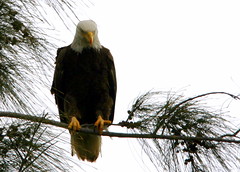 Our
latest information indicates that the Broward County School Board
intends to proceed with construction of the traffic signal. They must
balance the risk to public safety if they delay the project until the
eaglets fledge, against the possiblity that the disturbance to the
eagles cause them to abandon the nest, which could injure or kill the
chicks. Hopefully, they will utilize less intrusive methods,
particularly as they excavate the line that must pass in front of the
nest. Eagle watchers will be inconvenienced for a time, just when the
behavior of these birds is most interesting to watch. This morning, we
did not get a glimpse of the chick(s), as they had already been fed,
and an adult was sheltering them against the rather brisk breeze and
drizzle. The other adult stood watch on a tree just to the west of the
nest. See
today's Blog. Our
latest information indicates that the Broward County School Board
intends to proceed with construction of the traffic signal. They must
balance the risk to public safety if they delay the project until the
eaglets fledge, against the possiblity that the disturbance to the
eagles cause them to abandon the nest, which could injure or kill the
chicks. Hopefully, they will utilize less intrusive methods,
particularly as they excavate the line that must pass in front of the
nest. Eagle watchers will be inconvenienced for a time, just when the
behavior of these birds is most interesting to watch. This morning, we
did not get a glimpse of the chick(s), as they had already been fed,
and an adult was sheltering them against the rather brisk breeze and
drizzle. The other adult stood watch on a tree just to the west of the
nest. See
today's Blog.Friday, February 6, 2009 The
eaglet is stronger, holding its head up above the rim of thenest more
frequently. I am not sure, but I think I saw movement to the left of
the chick pictured here, suggesting at least one other is present.
Still waiting to hear about whether the Broward School Board
intends to proceed with construction only 200 feet from the nest. FWC
has recommended that they delay excavation until the eaglets fledge,
probably in late April or early May, if they survive.
Wednesday, February 4, 2009 This
afternoon I was able to get a photo of an
eaglet reaching up as it was being fed. Had better looks
through
the binoculars, but, at the left, you can see the
light-colored
down and a bit of the dark area around its eyes. It engaged in a
tug-of-war with its parent over a the bloody viscera of a prey item.
 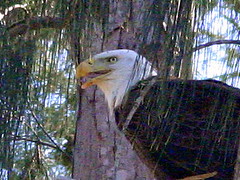 See notes about the status
of construction at the nest site
Tuesday, February 3, 2009: First Eaglet is 17 days old 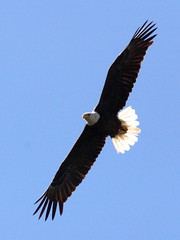 Yesterday,
Kelly Smith reported (her note is below, in the Comments Forum)
seeing "at least" two downy light gray heads of eaglets
bobbing
above the rim of the nest. They had large dark areas around their eyes.
Naturally, Mary Lou and I went over this morning around 10:00
AM,
hoping to photograph them. Our two little granddaughters and their
mother, visiting from Chicago, accompanied us. We watched for almost an
hour, joining an affable group from Palm Beach who had been there since
around 8:00 for the same reason. One adult stood on guard the
entire time, and we could not see the chicks. After taking the children
to McDonalds for lunch, we returned a little after 12:30 PM. This time
there were two adults at the nest site. One was on the edge of the nest
and the other roosted just above. They took turns flying about. There
was no feeding activity, and again no sight of the eaglets. I did get
some nice flight photos. Placed a new "slideshow" feature on
the eagle Web pages. Yesterday,
Kelly Smith reported (her note is below, in the Comments Forum)
seeing "at least" two downy light gray heads of eaglets
bobbing
above the rim of the nest. They had large dark areas around their eyes.
Naturally, Mary Lou and I went over this morning around 10:00
AM,
hoping to photograph them. Our two little granddaughters and their
mother, visiting from Chicago, accompanied us. We watched for almost an
hour, joining an affable group from Palm Beach who had been there since
around 8:00 for the same reason. One adult stood on guard the
entire time, and we could not see the chicks. After taking the children
to McDonalds for lunch, we returned a little after 12:30 PM. This time
there were two adults at the nest site. One was on the edge of the nest
and the other roosted just above. They took turns flying about. There
was no feeding activity, and again no sight of the eaglets. I did get
some nice flight photos. Placed a new "slideshow" feature on
the eagle Web pages.Friday, January 30, 2009: Wet eagles There
was dense fog when we arrived at the nest around 8:30 AM. One adult was
standing guard atop a melaleuca snag to the west of the nest
tree, wings extended. It may have had prey in its talons, but
we
could not tell for sure. The other was sitting rather close. Both were
obviously very wet. It had not rained, but condensation had collected
on the pine needles and it almost looked like it was raining under its
the branches.
After about 10 minutes of sitting patiently, the bird on the nest suddenly got up and flew over to the roosting bird, calling. The other bird took flight, and they continued chirping to each other. One then flew directly back to the nest. I could not see whether it brought a prey item in, but it obviously began tearing at some kind of carcass and then spent quite a bit of time feeding the eaglet(s), which remained invisible. While the adult was pecking at the prey, emergency vehicles came by, their sirens screeching. The eagle did not change its behavior at all, an indication that it was quite well-adapted to such a disturbance. After it finished feeding the young, it settled back and brooded them until we departed around 9:15. My photos were of poor quality, due to the fog and the fact that I did not compensate for the poor lighting. Tuesday, January 27, 2009: Eaglet visible in nest This morning we watched the nest for 50 minutes. The first eaglet is now 11 days old. Several times, we saw the eaglet's head bobbing part-way up, visible through the tangle of sticks . Here are side-by-side photos for comparison-- visit http://flickr.com/photos/rosyfinch/3231896744/ for larger views. The firsrt shows the rounded white head of the chick, against the dark background of the tree trunk. The second, from the same location a few seconds later, shows that the eaglet's head has disappeared. 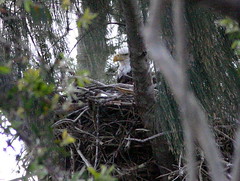 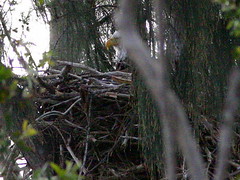 Monday, January 26, 2009 We
have learned from Scott Brunner, P.E., the Broward County Signal
Operations Engineer, that the signal at Pines Boulevard and
209th
Avenue is not being installed by Broward County, but by the Broward
County School District and their consultants/contractors through a
Florida Department of Transportation permit. The FWC has
provided
valuable cautions and advice to the contractor, and will be following
events closely. The excavation may not involve the shoulder
of the road in front of the eagle nest. See the full story at
this link.
Thursday, January 22, 2009  We
observed the nest this morning from 10:00 until 11:00 AM. The
brooding adult sat quite low, but began calling at about
10:35,
when its mate suddenly appeared with a small prey iitem,
nature
unknown. The adults appeared to be feeding small particles to the
chick(s), but none were visible from our vantage point. Thankfully, the
temperature did not get as low as predicted, as it was only 40 degrees
at ground level. There was no construction activity. Please
refer
to the update on the signal construction, here
on the "History" page. We
observed the nest this morning from 10:00 until 11:00 AM. The
brooding adult sat quite low, but began calling at about
10:35,
when its mate suddenly appeared with a small prey iitem,
nature
unknown. The adults appeared to be feeding small particles to the
chick(s), but none were visible from our vantage point. Thankfully, the
temperature did not get as low as predicted, as it was only 40 degrees
at ground level. There was no construction activity. Please
refer
to the update on the signal construction, here
on the "History" page.Wednesday, January 21, 2009 After
quite a bit of "digging," we discovered that the excavation planned for
the area just in front of the "Eagle Forest" involves the
installation of a traffic signal. The work is being done by the Broward
County Traffic Engineering Division. They appear not to have obtained a
permit from the Florida FWC, as is required for any construction within
660 feet of an active Bald Eagle nest. We have appealed to the FWC to
enforce the State and Federal regulations, and hope that the
construction will be deferred until the eaglets are fledged and flying
free, which should be in early May. See today's Blog
for more information and updates.
Monday, January 19, 2008 (Click on thumbnails for larger images) 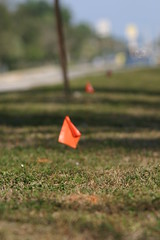 Left:
Utility marking flags are lined up the entire length Left:
Utility marking flags are lined up the entire length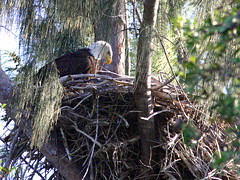 of the block in front ot the
"Eagle Forest." The
City of Pembroke Pines offices were closed today, so we do not
yet know what type of excavation or construction is planned at the
eagle nest site. of the block in front ot the
"Eagle Forest." The
City of Pembroke Pines offices were closed today, so we do not
yet know what type of excavation or construction is planned at the
eagle nest site. Right: This afternoon, the eagles were very active. When we arrived around 4:00 PM, the brooding adult got up several times and put its head down into the nest cup. Right: The second adult arrived with a large 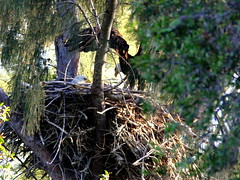 prey item-- it seemed too bulky to be a
fish, but an Osprey did follow the eagle to prey item-- it seemed too bulky to be a
fish, but an Osprey did follow the eagle tothe nest area, suggesting that the eagle may have pirated it from the smaller raptor. 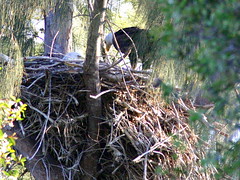 Left: The arriving bird tore at the prey and appeared to remove small morsels, which it transferred to the brooding bird. The latter then appeared to feed the nestling.We could not actually see the eaglet from the ground.  Lower
Left:
This time we thought that the newly arrived bird displaced the other
and took over brooding and incubation duties, but we were not
absolutely sure. Here it is shown exiting the nest. Lower
Left:
This time we thought that the newly arrived bird displaced the other
and took over brooding and incubation duties, but we were not
absolutely sure. Here it is shown exiting the nest.There were several eagle watchers present, including some of the middle school science class students who are participating in the eagle research project. Good news: the project is one of four in the School District designated to receive a Department of Education grant to support additional research, which may include satellite tracking of an eaglet if any survive to fledge. Sunday, January 18, 2009: Eaglet Appears To Have Hatched! 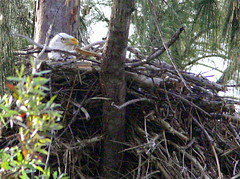 8:15
AM: (Left) Single adult is incubating. It
appears restless, changing its position several times. Up until now,
the incubating bird sat far down, nearly out of sight in the nest cup. 8:15
AM: (Left) Single adult is incubating. It
appears restless, changing its position several times. Up until now,
the incubating bird sat far down, nearly out of sight in the nest cup. 8:40
AM: (Right) After about a half hour, its mate
appeared. We
expected them to exchange incubation duties as has been observed
several times in the past.
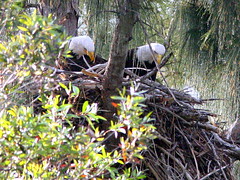 8:45 AM: (Left) Instead of
exchanging incubation duties, the pair just stood together, peering
down into the nest . 8:45 AM: (Left) Instead of
exchanging incubation duties, the pair just stood together, peering
down into the nest .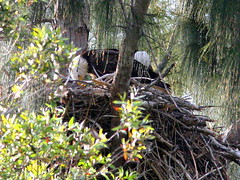 8:50
AM (Right) The bird that had been incubating did not depart. Instead,
it seemed to be picking at something hidden within the nest cup. After
the two had been together for about ten minutes, the other bird flew
off without displacing the incubating bird. This behavior suggests that
one of the eggs has hatched since yesterday.
Much has transpired since my last note. On the evening of January 16th, Kelly Smith noted that flags marking underground utilities had been placed along Pines Boulevard the entire length of the block, right in front of the "Eagle Forest." This usually means that some kind of construction is imminent. Since this is a long weekend, we may not be able to find out until Tuesday exactly what is planned. Since the flags are only about 200 feet from the nest, and the chicks will be especially vulnerable to disturbance at this time, we are alarmed and will ask the City of Pembroke Pines to defer any non-emergency construction until after the end of the breeding season, which should be early May. Follow events concerning this new threat in Ken's Blog. January 16, 2009 See
my note below in the "Comments" forum. Watched nest for almost an hour
this morning. One eagle roosting nearby flew away when we arrived at
7:00 AM. Could not see the eagle in the nest until it raised
its
head and looked out between the branches at the left side of the rim of
the nest. Today is the 34th day of incubation, if we correctly timed
the laying of the first egg. Maybe tomorrow!
January 14, 2009-- 32nd Day of Incubation See Kelly
Smith's note below in the "Comments" Forum. We must now be alert for
behavioral signs that the first
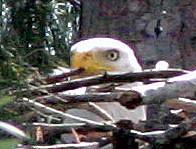 egg has hatched. As Kelly notes, the incubating adult must then attend
to two duties: keeping the remaining egg warm and also sheltering
the little eaglet without crushing or smothering it.
Instead
of remaining barely visible below the rim of the nest cup, the brooding
adult is forced to stand up inside the nest. Since we expect the eggs
to hatch by this Saturday, January 17th, observers should be alert to
such a change, and report it in the message box below. This photo is a
greatly enlarged crop of the incubating adult. To the
left,also
taken today, the adult is barely visible on the nest as it changes
position by turning 180 degrees to adjust nesting materials, or
possibly turn the eggs. The eaglets may now be making peeping sounds
within the eggs, audible only to the incubating adult.
egg has hatched. As Kelly notes, the incubating adult must then attend
to two duties: keeping the remaining egg warm and also sheltering
the little eaglet without crushing or smothering it.
Instead
of remaining barely visible below the rim of the nest cup, the brooding
adult is forced to stand up inside the nest. Since we expect the eggs
to hatch by this Saturday, January 17th, observers should be alert to
such a change, and report it in the message box below. This photo is a
greatly enlarged crop of the incubating adult. To the
left,also
taken today, the adult is barely visible on the nest as it changes
position by turning 180 degrees to adjust nesting materials, or
possibly turn the eggs. The eaglets may now be making peeping sounds
within the eggs, audible only to the incubating adult.January 9, 2009 At
around 7:45 there was one adult sitting very low in the nest. This is
day #27 since the first egg was laid. We can hope that the first egg
will hatch in about one week.
December 23, 2008 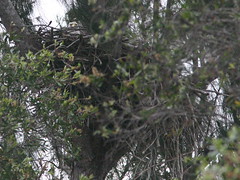 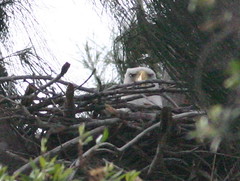 Today, the eagles will complete their 10th day of
incubation. This
morning, I photographed one member of the pair, its head barely showing
above the rim of the nest. Note that it seems to be staring
at me
intently. Today, the eagles will complete their 10th day of
incubation. This
morning, I photographed one member of the pair, its head barely showing
above the rim of the nest. Note that it seems to be staring
at me
intently. Its mate was not visible in the vicinity of the nest. My December 13th photograph of the nest (shown below) caused me some concern, as the right side of the structure appeared to show some disruption, which I thought might have been due to the heavy winds that accompanied a cold front on the previous day. Comparing the two photos, there appears to be no obvious change over the 10 day period, possibly a hopeful sign that the nest was not seriously damaged. Click on the images for larger views. December 17, 2008: Incubating Eagles Swap Duties The
eagles are definitely incubation their egg(s), as a bird is on the nest
all the time. Today, Kelly Smith said that she witnessed a "changing of
the guard" this morning, and added aninteresting observation about
their behavior: "Just as I was about to leave, an eagle flew in to the
nest and just as quickly the occupant hopped up and flew off.
It
took only a few moments for the relief eagle to settle into the nest
and disappear below the rim. A funny thing happened with the
other eagle. It had flown to the tree nearby that they
frequently
perch on. Several times it put its head down and looked just
like
it does when it is looking down into the nest. It was a
strange
stance that I have not seen them exhibit other than when they were
actually in the nest. Hmmm... some innate behavior?"
December 13: Eagles Appear to be Incubating Egg(s) 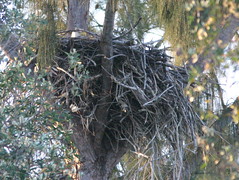 Yesterday
and today, the eagles stopped bringing in nesting materials, and one of
the birds has been sitting on the nest for extended periods of time. We
suspect that the first egg has been laid and that the birds are
incubating. Another egg should follow within 2-3 days (rarely a third).
Since the eggs are incubated from the time the first is laid, the
eaglets hatch out sequentially, rather than both at once. This gives
the advantage to the first-hatched chick, as it will be stronger and
compete fiercely for food. If food is scarce, the younger chick may
starve to death, or even be killed by its nest-mate. The usual
incubation period is 35 days, so we may expect the eggs to hatch around
January 17th. If one or more eaglets survive, they should be able to
fly from the nest at 11-12 weeks of age, in early April. Yesterday
and today, the eagles stopped bringing in nesting materials, and one of
the birds has been sitting on the nest for extended periods of time. We
suspect that the first egg has been laid and that the birds are
incubating. Another egg should follow within 2-3 days (rarely a third).
Since the eggs are incubated from the time the first is laid, the
eaglets hatch out sequentially, rather than both at once. This gives
the advantage to the first-hatched chick, as it will be stronger and
compete fiercely for food. If food is scarce, the younger chick may
starve to death, or even be killed by its nest-mate. The usual
incubation period is 35 days, so we may expect the eggs to hatch around
January 17th. If one or more eaglets survive, they should be able to
fly from the nest at 11-12 weeks of age, in early April.
December 11, 2008: Time to Lay Eggs Approaching This morning, at around 7:30, both of the eagles were on the nest. One took off, leaving the other partially hidden within the nest. After a few minutes, the other flew away. Within 10 minutes, we saw both eagles flying across Pines Boulevard to the northwest, where they circled low and dropped out of sight. Very soon, one returned to the nest carrying a large branch in its talons, followed within 30 seconds by the other, carrying a smaller stick. The eagle to the left in this photo worked on the nest while the other appeared to be standing on guard. Then they touched bills and sat together for 5 minutes or so, before the one on the right flew off. The other remained nearly out of sight for another 15 minutes, until we departed. If the birds follow last year's schedule, their eggs should be deposited within the next few days. Eagles are known to be most sensitive to disturbance during the nesting period, especially when incubating the eggs and rearing their young. These birds nested successfully last season despite the proximity of their nest site to housing subdivisions, the busy road, the presence of a construction staging site within about 300 yards, and a shooting range within earshot. This year they face the potential for additional disturbance, as West Broward High School has opened, and at rush hour there are officers directing traffic and police cars with lights stationed at about the same distance from the nest. Additionally, since more people now know about the nest, there are often observers watching through binoculars and photographers, stationed about 100 yards from the nest. |
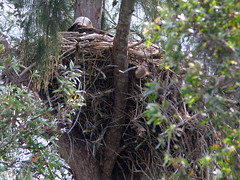 |
|
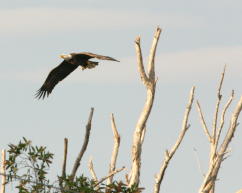 |
|
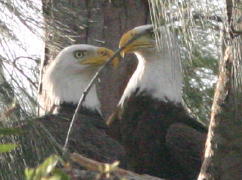 |
|
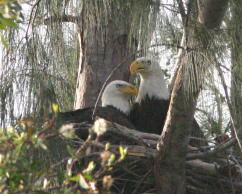 |
|
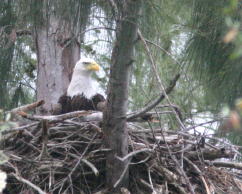 |
December 5, 2008: Eagle
Researcher Meets With Students
Today,
the Middle School students who will conduct the eagle observations were
treated to a talk by Brian K. Mealey, who heads the Institute of
Wildlife Sciences,
and conducts wildlife research in Everglades National Park (ENP). One
of his particular interests is the migratory dispersal of Bald Eagles
in South Florida. He described his program of banding and satellite
tracking of newly fledged eagles. On his Web site, it is
possible
to track the daily movements of "Birdie," a young eagle who hatched out
in Port St. Lucie, from her first practice flights, in early April, to
her return to Florida, in October, after migrating to Maryland
for
the summer. Track
"Birdie's" wanderings at this link.
The eagles of Central Florida are known to fly to points far to the north, soon after becoming independent of their parents. During early summer into late fall, they commonly congregate in the Chesapeake Bay area in Maryland. Interestingly, Brian's studies have revealed that birds from the southern tip of Florida almost always stay in Florida. If the Pembroke Pines pair are successful in fledging one or two eaglets, Brian hopes to be able to equip them with satellite tracking transmitters. As this nest is in the territory between eagles that take long flights north, and the ENP birds that do not migrate outside Florida, tracking of any offspring may provide important information about the relationship between nesting sites and the location of migration ranges. The students showed great interest and had so many questions that Brian could surely have gone on for another hour. December 3, 2008: Eagles are Carrying Nest Materials! Kelly
Smith, 7th Grade Science Teacher at Silver Trail Middle School writes:
Just wanted to let you know....
December
2, 2008: Photo of Eagle on Nest, and a CautionI hadn't seen both eagles together for about a week, and was beginning to worry that something had happened to one. To my great relief I spotted both of them this morning and wasn't I happy to see them carrying branches to the nest and arranging them. They made about 4 trips in the 20 minutes I stopped by to watch. We seem to be right on track with last year's schedule. At 8:30 this morning, I pulled up to park at the usual observation point just to the south of the "End School Zone" sign. One eagle was immediately visible, on the nest. To retrieve my camera, I had to get out of the car and open the trunk. My movements were slow and I did not slam any doors. Yet the bird on the nest became alert and restless. As I was photographing it, from the other side of the auto, it stood up and then flew off. It had remained on the nest only about one minute from the time I got out of the car. The lesson I learned is to suggest that observers remain in their vehicle, using it as a blind, especially when eagles are at or near the nest. If the car is properly positioned, just on the south side of the "End School Zone" sign, with the post directly in line with the observer(s), it will not be necessary to get out of the car. Of course, in the future I will arrive with my camera inside the car! |
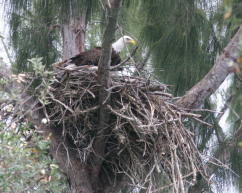 |